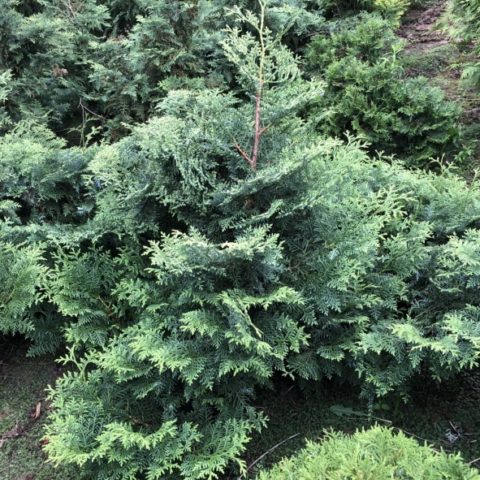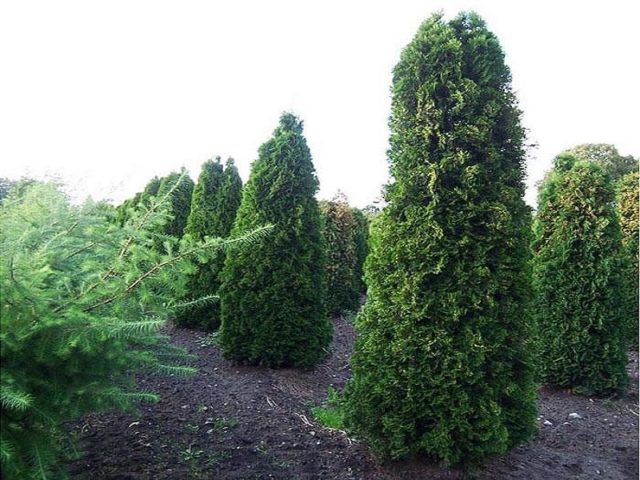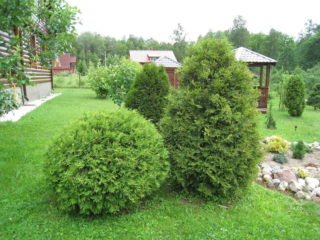Content
Creating a beautiful and well-groomed garden is the dream of any gardener. Thuja columnar, a beautiful plant that retains its bright appearance throughout the year, will help to implement it. It has a dense crown, beautiful shapes, and emits a wonderful pine aroma.
Columnar thuja has its own planting and care features, which are worth knowing about in order to avoid mistakes when growing.
Description of columnar thuja
The columnar western thuja belongs to the genus Gymnosperms, the Cypress family. Its natural habitat is considered to be East Asia, America, and Europe. In Russia, conifers are not found in natural conditions, but the tree is often grown in personal plots.
Under natural conditions, the height of the columnar thuja reaches 25 m, in a personal plot - no higher than 10 m. The tree has a powerful root system that extends deep into the soil. The bark of the plant gradually peels off, its color is brown or red. The crown shape is columnar and can reach 150 cm in width.The branches fit tightly to the trunk. The needles are scaly, rich green in color, and are completely replaced every two years.
Thuja does not have decorative flowers. After monoecious inflorescences fall, small brown cones with seeds inside remain on the shoots.
Thuja columnar is an unpretentious frost-resistant plant that tolerates dust and air pollution well.
Varieties and varieties
There are several main types of thuja:
- western;
- eastern;
- folded;
- Japanese;
- Korean.
Based on them, numerous varieties of thuja have been bred, having various forms:
Pyramidal, spherical, columnar, dwarf, cushion-shaped.
Many well-known varieties have a columnar shape.
Brabant
Western columnar thuja Brabant is characterized by rapid growth. In adulthood, the plant reaches 20 m in height, the diameter of its crown is 4 m, but in the middle zone it does not grow above 5 m.
The annual growth is 40 cm. The crown of the conifer is compact, branched, and reaches down to the ground. Thuja needles are green with golden tips. Its color remains in winter. The variety is classified as shade-tolerant, but the crop does not tolerate thaws well. The use of western columnar thuja, as described by amateur and specialist gardeners, is universal: in the form of individual and group plantings. To maintain its shape, the plant requires periodic pruning.
Columna
Columna is one of the best Western columnar varieties, which was bred in Germany. The growth rate of the crop is average. At the age of ten, the plant reaches 4 m in height and 1.5 m in diameter.
Later, the thuja can grow up to 10 m. Its crown is narrow and the top is blunt. The branches are directed horizontally and fan-shaped at the ends. The needles of the tree are small, glossy, dark green.
The thuja variety is frost-resistant and easy to care for. It is used for hedges and individual plantings. The plant does not need cutting.
Gelderland
This is a popular variety of columnar thuja (photo) with a folded appearance. The crown starts from the ground, its shape is cone-shaped and dense. The annual growth is 25 cm. An adult tree reaches 5 m. Its needles are soft, green in summer, golden-bronze in winter. Thuja is unpretentious, loves illuminated areas, and is not afraid of cutting. The culture is frost and drought resistant.
Holmstrup
Judging by the description and photo, the western columnar thuja Holmstrup has a dense, dense crown.
The height of the plant at the age of 10 years is 1.5 m with a crown diameter of 0.6 m. The annual growth of this conifer is 15 cm. In adulthood, the columnar thuja reaches 4 m. Its crown is narrow, the color of the needles does not change in winter. The tree is frost-resistant, undemanding to soils, and its use in landscape design is universal. It tolerates a haircut easily.
Excelsa
The evergreen columnar folded thuja has a trunk that goes to the top and arched branches. The tree grows very quickly, increasing by 30 cm per year.
Its maximum height is 15 m, width is 4 m. The needles of the columnar thuja Excelsa are dark green, shiny, rough, and scaly in appearance. The fruits are oblong cones 12 mm long. In summer they are green, in winter they are brown. The plant is shade-tolerant, wind- and frost-resistant, and easily tolerates pruning.
Zmatlik
Dwarf columnar thuja forms a narrow crown. At a young age, it is not entirely clear, but rather disheveled and ugly; the trunk may be curved. The growth of an adult tree reaches 1 m. Its needles are small and dark green.Columnar thuja has sinuous, fan-like branches that create spirals and waves. The plant loves sunny areas; in the shade its crown thins out.
Application in landscape design
Columnar thuja is often used to create hedges, which can easily replace conventional fences. At the same time, they not only look beautiful, but also absorb dust and other air pollutants. When planted at a distance of 0.5 m, a dense wall of plants is formed.
In the arrangement of rock gardens, dwarf compact columnar thujas are used. Slow-growing varieties allow timely adjustment of the crown shape. Thujas can be planted in groups or individually.
When organizing mixed flower beds, you should apply the principle of a natural landscape, where different plants are combined. Such mixborders look stylish at any time of the year. Together with columnar thujas, saxifrage, heather, red roses, dahlias, astilbes, and hydrangeas are used. The combination of contrasting shapes and shades gives an amazing effect.
The folded thuja perfectly complements the flower garden with its fluffy crown.
Columnar thujas, standing alone on the lawn, decorate it and make it unique, different from many others.
Features of reproduction
Columnar thuja can be propagated by cuttings or seeds.
The second method takes about 5 years to grow. The decorative properties of thuja are preserved by this. Ripe cones with seeds are placed in a warm place. After opening, the seeds are removed, soaked for 10 hours and sown. After a year, the height of the plant reaches 60 cm.
The cutting method involves planting columnar thuja shoots in the fall in a warm and humid place. The soil composition includes sand, turf soil, and peat. The shoot should be lignified, treated with a growth stimulant.After rooting, the seedling is grown and planted in a permanent place.
Landing rules
Planting a columnar thuja involves performing a number of actions:
- Decide on a site for the location of thujas.
- Prepare the soil thoroughly.
- Mark the distance between the holes in accordance with the intended purpose (hedge or individual plantings).
- Dig planting holes that correspond to the parameters of the root system of the seedlings.
- Make drainage from expanded clay or broken brick.
- Plant columnar thujas.
- Water the plants.
- Mulch the soil.
- Protect the crown from direct sunlight.
Recommended timing
Experts recommend planting columnar thuja in early spring. The best time for this is the end of March, as soon as the soil and air warm up. Before winter, the seedling has time to grow stronger, grow roots and crown, and its shoots become coarser. In this state, the plant overwinters safely. At later dates, there is a possibility that it will not take root due to the summer heat.
In autumn, columnar thujas are planted in the middle zone no later than September. It is better to purchase a plant with a closed root system so that injury is minimal.
Site selection and soil preparation
When choosing a place and soil for planting columnar thuja, you should be guided by a number of criteria:
- the area should be well lit;
- in a region with very hot summers, it is permissible to place the columnar thuja in a slight shade;
- care should be taken to ensure that there are no winds or drafts in the area;
- the soil should be light, fertile, breathable, and drained;
- Columnar thuja loves acidic soil, but grows poorly in overly dry or waterlogged soil;
- High groundwater levels, swampy areas and lowlands should be avoided;
- It is not recommended to plant thuja too close to tall trees; the minimum distance to them is 4 m.
Landing algorithm
After the preparatory work, you can begin planting the columnar thuja:
- Water the seedling generously 2 hours before planting, using a growth stimulator solution.
- Remove the seedling from the pot along with a lump of earth.
- Place it in the center of the hole.
- Fill the voids with soil mixture so that the root collar is 3 cm above the ground surface.
- Water generously.
- Add more soil if the soil has settled.
- Make a roller of earth around the thuja.
- Mulch the tree trunk with peat, bark, and pine litter.
- Shade the crown of a young plant.
Rules for growing and care
For successful growth and development of thuja columnar, it is necessary to carry out regular watering, especially in the first time after planting. Removing weeds, loosening and mulching the soil around the plant helps retain moisture and make it breathable. Fertilizing the thuja is not necessary, but if the soil is poor, it is worth adding fertilizer. Pruning is carried out as necessary or in order to give a certain shape to the crown.
Watering schedule
If columnar thujas are planted in spring or summer, they should be watered regularly, at least once a week. In hot weather, the frequency should be increased to twice every seven days. The watering norm for one plant is 10 liters. In extremely hot conditions it is doubled.
Experts recommend sprinkling or surface watering in the first month after planting a columnar thuja. It helps open the pores of the needles, after which they begin to actively release aroma. The best time to moisturize is in the evening, after sunset.
A plant that has undergone autumn planting needs to be saturated with moisture for a successful winter. At the end of September it should be watered abundantly.
Top dressing
To feed columnar thuja, both organic and mineral fertilizers are used. The main principle is “it’s better not to overfeed.” Large doses lead to rapid growth, but at the same time the shoots become less dense and decorative.
On poor soils, additional nutrients are added at the root of the thuja and through sprinkling. In spring, plants need nitrogen, in autumn - phosphorus.
It is possible to carry out additional organic fertilizing in the summer - using an infusion of ash, an aqueous solution of slurry in a ratio of 1 to 20.
Trimming
Haircut of columnar thuja is carried out for sanitary purposes or to give a certain shape to the crown. Time: spring-autumn.
When sanitary pruning, diseased, damaged shoots are removed.
The crown is shaped by pruning according to the following rules:
- the optimal age of the plant is 4 years;
- no more than 1/3 of the shoots are removed in one procedure;
- cut areas should be treated with garden varnish;
- haircut is carried out in cloudy weather;
- immediately after it the plant must be watered;
- when forming a haircut, they create a shape, focusing on the original appearance of the thuja, improving it and slightly correcting it.
Preparing for winter
An adult columnar thuja overwinters well and does not need shelter.
In the first years after planting, a young plant may suffer from frost, cold wind, abundance of snow, or bright sun in early spring. Its protection is carried out in late autumn as follows:
- Lay mulch in a layer up to 20 cm thick over the entire area of the tree trunk circle.
- The crowns of small columnar thujas are covered with non-woven material or bags and secured with ropes.
- For medium-sized thuja seedlings, frames are made, onto which covering material is later stretched.
- In winter, it is worth regularly clearing shelters of snow so that the shoots are not damaged under its weight.
- In spring, the protection is removed gradually so that the needles do not get burned.
The level of decorativeness of the columnar thuja next spring depends on the quality of preparation for winter.
Pests and diseases
As you can see in the photo, the western columnar thuja has a beautiful needle color and attractive shape.
The plant rarely suffers from diseases and pests. But under unfavorable weather conditions, high humidity or flooding of the root system, fungal diseases can occur: brown chute; rust; gray mold; Fusarium
Damaged shoots are removed and disposed of, and the plants are treated with chemicals.
Among the pests of columnar thuja that pose a serious threat to it are: bark beetles, sawflies, hermes, and scale insects.
To combat them, insecticides and folk remedies are used.
Conclusion
Thuja columnar will not require complex and constant care if you plant it according to all the rules and choose the appropriate place. The brightness of the color of the needles, the aroma, the stylish appearance of the plant are the reasons why you should decorate your site with the help of this tree and watch its growth and development for many years.
Reviews

























